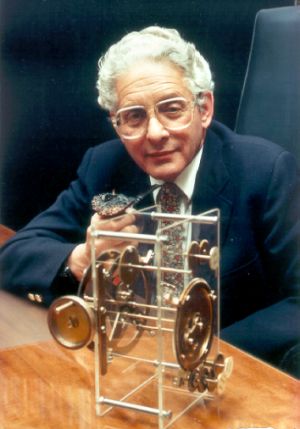Science Since Babylon
Science Since Babylon was written by Derek J. de Solla Price based on a series of five lectures he delivered at Yale University's Sterling Memorial Library in October and November 1959 on the history of science. In 1961 it was published in London and New Haven by Yale University Press, and sold as a Yale Paperbound (paperback) in 1962. It is notable due to Price's observation of the exponential trajectory of scientific growth, and his subsequent prediction of that growth leveling off due to saturation. The book is often cited by Eric Weinstein for its observations about growth. Weinstein also notes that it is odd how few people know about this book.
An Open Access PDF of the book is available here.
Preface to Enlarged Edition
Preface to Original Edition
1. The Peculiarity of a Scientific Civilization
Summary
References
2. Celestial Clockwork in Greece and China
Summary
References
- Whipple Museum of the History of Science
- Astrolabe
- A Treatise on the Astrolabe by Chaucer
- Escapement
- Astrarium, a clock built by Giovanni de' Dondi in 1364
- Science and Civilisation in China, initiated and edited by Joseph Needham
- Song dynasty
- Antikythera mechanism, short documentary
3. Automata and the Origins of Mechanism and Mechanistic Philosophy
Summary
References
- Jean Froissart's L'Horloge Amouresuse and L'Horloge de Sapience
- Albertus Magnus
- St Thomas Aquinas' Summa Theological
- "beast-machine"
- Jonathan Swift's Yahoos
- Pascal's Pascaline of 1645: how it works
- musical automata of Achilles Lagenbucher of Augsburg
- waterworks of Canterbury Cathedral
- Duc Philippe, Count of Artois, castle of Hesdin, and the Garden of Earthly Delights, described in Magic and Mechanics in Medieval Fiction by Merriam Sherwood
- Polish scholar Witello
- Tower of the Winds, The Roman Agora in Athens: drone tour
- Strassbourg astronomical clock, made by Isaac and Josias Habrecht— watch it in action
- Cornelis Drebbel and his magical oven
- Cave of Lascaux: virtual tour, wiki article
4. The __, __, and __, and Other Geometrical and Scientific Talismans and Symbolisms
Summary
References
5. Renaissance Roots of Yankee Ingenuity
Summary
References
6. The Difference Beteween Science and Technology
Summary
Quotes
- "Do we really have to stoop so low as to lie about it again and maintain that the latest, biggest accelerator will help us make useful things? Do we need to support mathematics for the direct utility? No, not at all. We can adopt a science-for-science’s-sake policy, provided we are clear that this can always be justified by the weak but vital link with technology. We need science so that technologists may grow up immersed in it. I do not avoid the intellectual argument that we also do it because it is the most difficult and elegant thing we can do. Like Everest it is there. The question of justification only becomes important because we ask that society pay for it, and there must therefore be some sort of social contract. Some reason must exist for society to pay; in our age, if you spend on that you must go without something else. The tradition of libertas philosophandi, the freedom to follow learning wherever it may lead, is now questioned yet again in the way in which it was questioned by the ancient Romans, by the French revolutionaries, and most recently by communist Hungary. They all thought they could junk useless sciences and pay only for the useful ones. Their civilizations and states were visibly ruined by this tragic policy. It cannot be played like that. The reason is the educational process." p 131-132
References
7. Mutations of Science
Summary
References
- Antoine Lavoisier
- Joseph Priestley
- Friedrich Wöhler
- Phlogiston theory
- The History Of The Phlogiston Theory by John Henry White
- James Clerk Maxwell
- Fin de siècle
- J. J. Thomson
- Cavendish Laboratory
- William Crookes
- Wilhelm Röntgen
- Henri Becquerel
- X-ray
- N ray
- Prosper-René Blondlot
- Nancy-Université
- Heinrich Rubens
- Robert W. Wood
